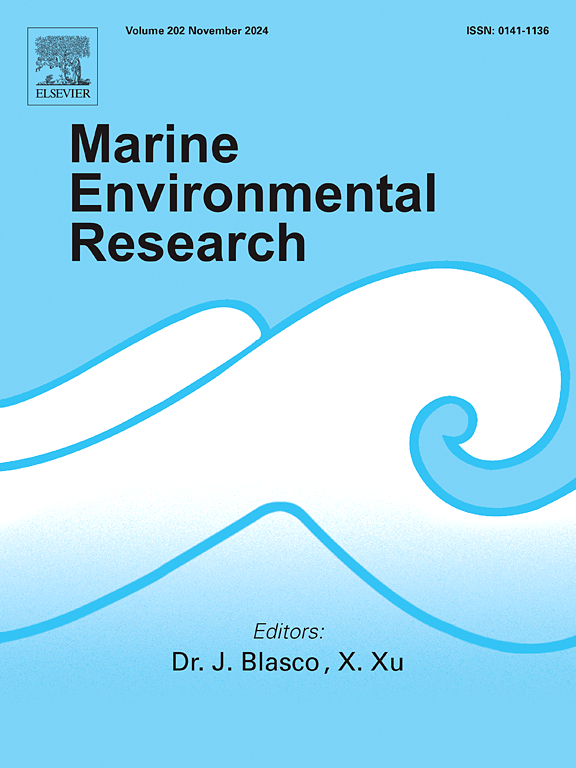Pollution in marine bivalves: The immunosuppressive effects of microplastics on Anadara granosa
IF 3
3区 环境科学与生态学
Q2 ENVIRONMENTAL SCIENCES
引用次数: 0
Abstract
Microplastics (MPs), as emerging marine pollutants, pose a significant threat to marine organisms and ecosystems. This study investigates the effects of 7-day MPs exposure on the immune response of the blood clam (Anadara granosa), a commercially valuable marine bivalve known for its filter-feeding and sedentary lifestyle, which renders it particularly vulnerable to pollutants. This study analyzed the impact of various concentrations (0, 0.1, 1, and 10 mg/L) of polystyrene MPs (PS MPs) on the immune response of blood clam hemocytes, focusing on the mechanisms of immunotoxicity, including changes in hemoglobin content, reactive oxygen species levels, cell viability, and the expression of immune-related genes. The findings indicate that a one-week exposure to PS MPs significantly compromised the immune response of blood clam hemocytes, exhibiting a pronounced dose-dependent relationship. There was a significant reduction in the total hemocyte count, concentration of hemoglobin, lysozyme content, and activity following PS MPs exposure. Additionally, the levels of calcium ions, the activities of acid and alkaline phosphatases varied with the concentration of PS MPs, suggesting that increased PS MPs concentrations suppress the immune activity of blood clams. This suppression could diminish their capacity to fend off external aggressions and heighten the risk of disease outbreaks. The study provides novel insights into the impact of PS MPs on the immune response of marine bivalves and lays the groundwork for further ecotoxicological research.

海洋双壳类动物的污染:微塑料对阿纳达拉的免疫抑制作用
微塑料作为新兴的海洋污染物,对海洋生物和生态系统构成重大威胁。本研究调查了7天的MPs暴露对血蛤(Anadara granosa)免疫反应的影响,血蛤是一种具有商业价值的海洋双壳类动物,以其滤食和久坐的生活方式而闻名,这使得它特别容易受到污染物的影响。本研究分析了不同浓度(0、0.1、1和10 mg/L)聚苯乙烯MPs (PS MPs)对血蛤血细胞免疫应答的影响,重点探讨了其免疫毒性机制,包括血红蛋白含量、活性氧水平、细胞活力和免疫相关基因表达的变化。研究结果表明,暴露于PS MPs一周显著降低了血蛤血细胞的免疫反应,表现出明显的剂量依赖关系。暴露于PS MPs后,总血细胞计数、血红蛋白浓度、溶菌酶含量和活性显著降低。此外,钙离子水平、酸性磷酸酶和碱性磷酸酶活性随PS MPs浓度的变化而变化,表明PS MPs浓度的升高抑制了血蛤的免疫活性。这种压制可能削弱它们抵御外来侵略的能力,并增加疾病爆发的风险。该研究为PS MPs对海洋双壳类动物免疫反应的影响提供了新的见解,并为进一步的生态毒理学研究奠定了基础。
本文章由计算机程序翻译,如有差异,请以英文原文为准。
求助全文
约1分钟内获得全文
求助全文
来源期刊

Marine environmental research
环境科学-毒理学
CiteScore
5.90
自引率
3.00%
发文量
217
审稿时长
46 days
期刊介绍:
Marine Environmental Research publishes original research papers on chemical, physical, and biological interactions in the oceans and coastal waters. The journal serves as a forum for new information on biology, chemistry, and toxicology and syntheses that advance understanding of marine environmental processes.
Submission of multidisciplinary studies is encouraged. Studies that utilize experimental approaches to clarify the roles of anthropogenic and natural causes of changes in marine ecosystems are especially welcome, as are those studies that represent new developments of a theoretical or conceptual aspect of marine science. All papers published in this journal are reviewed by qualified peers prior to acceptance and publication. Examples of topics considered to be appropriate for the journal include, but are not limited to, the following:
– The extent, persistence, and consequences of change and the recovery from such change in natural marine systems
– The biochemical, physiological, and ecological consequences of contaminants to marine organisms and ecosystems
– The biogeochemistry of naturally occurring and anthropogenic substances
– Models that describe and predict the above processes
– Monitoring studies, to the extent that their results provide new information on functional processes
– Methodological papers describing improved quantitative techniques for the marine sciences.
 求助内容:
求助内容: 应助结果提醒方式:
应助结果提醒方式:


